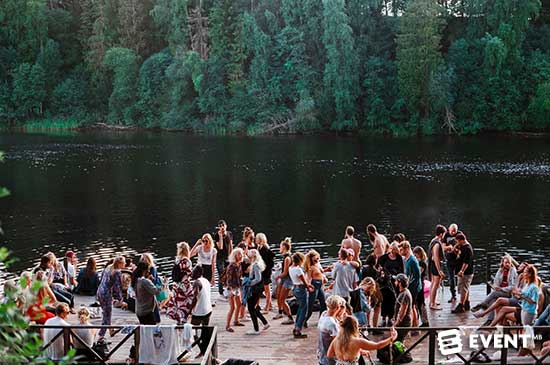Skift Take
What are the key components of a successful experiential marketing campaign and how can event planners use live brand marketing to its full advantage without it costing the earth?
Experiential marketing is live event marketing that engages an audience with a brand like nothing else. Clips of experiential marketing often go viral because of the excitement it creates. These events are often held in public places and cause a “stir.” But in order to create a popular experiential marketing campaign there are a number of things you need to do and think about.
Do you think experiential marketing could work for your brand, clients or next event? Maybe you’ve considered it but shied away because you think it’s out of your budget? Experiential marketing is hot and there’s no reason to avoid it. Whether for a brand big or small and whether you have a sizeable budget or otherwise, here is everything you need to know about becoming successful at creating experiential marketing campaigns.
##abovethefold##
5 Key Components of a Successful Experiential Marketing Campaign
- Traffic. Host it in a highly trafficked area. You need people to stumble across it and want to participate. You also want to limit the time they are able to do so in order to create scarcity. You can do experiential mail marketing but building that energy and buzz through paper is much more difficult.
- Activity. For best results, employ an active component. This isn’t about getting your audience to watch your new marketing video. You need an active component to drive engagement.
- Branding. If you go to great lengths to attract a crowd the last thing you want is people asking, “What was the point of that?”. You want them to know who was behind the experiential marketing or it won’t be a branding exercise and thus won’t be successful.
- Video. In a good experiential marketing event, participants will capture it on video and share it to social media. But since you want reliable footage of good quality, the only way to ensure that is by doing it yourself.
- Shares. Social media is essential to a good campaign. Again, others will probably do this for you, but sharing it with your audience will help you build momentum, get people talking, and help those who weren’t in attendance enjoy it as well.
What Goes Into Experiential Marketing?
In addition to the five things listed above that make a successful experiential marketing campaign, it’s important to note that experiential marketing uses several different kinds of marketing. This is a campaign with moving parts. It’s not simply an event. For a successful experiential marketing campaign you may use:
- An experience. You need to create something memorable for the audience. This may involve technology, celebrity appearances, contests, or giveaways.
- Social media marketing. You must create a strategy on how you will use the social webs to spread your event.
- Pop ups. Some experiential marketing includes pop-up retail offerings or tastings to capitalize on the excitement.
- Public relations. Having someone who specializes in telling the story and getting the word out is helpful.
- A strategy. You can host the coolest event ever but if it doesn’t tie into a business goal, it’s all just a lot of showboating.
Why Should You Use Experiential Marketing
At its most basic level, businesses employ experiential marketing because it makes a big impression. People remember it, talk about it, and share it. It’s marketing gold and because of that, it can be pricey.
The Huffington Post Canada proclaimed in an article that Experiential Marketing will Rule 2017. Here are a few other reasons why they just might be right:
- It creates great content.
- It forms connections and shows a different side of your organization.
- Experiential marketing is fun and audience’s love fun.
- Your brand may be stronger when experienced. There are some brands that people just need to feel, see, touch, or taste.
- You’ll stand out in person and on social media. That’s not easy to do these days.
- It gets your product into people’s hands instead of placing the onus on them to try you out.
- People who experience your brand will often feel interested enough to take action and purchase your product or service.
Is Experiential Marketing Just for Big Brands?
The reason big brands are drawn to experiential marketing is because it has an impact. But they also have deep pockets and most experiential marketing events are costly shows. However, they don’t have to be. You can make a big splash with very little money too. It just takes some planning and creativity.
How to Use Experiential Marketing on a Budget
Get Creative. Creativity rules when your budget is on the smaller side. Get your thinking cap on and dream of ways you can make an impression on the crowd. Think about what you want people to take away about your company as a starting point.
Use the Five Senses. Our senses create some of our most vivid memories. Think back to childhood and I bet there are smells that reignite memories good or bad. If you want to create an indelible memory, look for ways to involve the audience’s five senses.
Provide Samples Creatively. If you sell a product, look for ways to sample your item. This could involve pop-up tastings or on-the-spot free trials. This tactic moves products for two reasons. If you have a great one, sampling will get people interested. But most people also feel obligated when you give them something to give you something (like a sale or a donation) in return.
Go Big or Go Home. Flash mobs cause people to turn around and watch and they aren’t expensive to organize. Many of them are comprised of volunteers. You can use flash mob dancers, singers, or even stunt people.
Do Something Shocking. Take a lesson from Nestle’s experiential marketing campaign for Natural Bliss coffee creamer. The point behind the product is that it is natural. What better way to illustrate that than by setting up a pop-up coffee shop with baristas in au naturel attire and body paint. It was shocking but fairly inexpensive. I’m not sure what the health department would think of nudists serving hot beverages but it definitely got people to pay attention.
Grassroots Marketing. Grassroots or guerilla marketing involves a group of marketing foot soldiers. Just don’t use the kind with annoying clipboards who chase you down (ahem, Delta Airlines credit card). Most of us want to be part of the crowd. There’s safety in it and there’s often a fear of missing out if you believe everyone else is doing it. Assembling brand ambassadors can be done relatively inexpensively if people already love your brand. Send these folks to the street or encourage them to create video footage on behalf of your brand.
The Steps for Experiential Marketing Success
As mentioned previously, you’re looking to make a big impression through creating an audience experience in event marketing. Experiential marketing works best when your demographic is large. If you have a niche audience, make sure you go where they are or launch a very targeted campaign. If you don’t, you’re wasting money and time on people who won’t be buying your product or service. Here’s 11 steps on how to build a successful experiential marketing campaign.
- Decide what you want. If this event makes you a household name what is it you want from that? More sales, the opportunity to educate potential customers, a larger mailing list, notoriety, to start a conversation with customers, or get celebrities to enjoy your product? Whatever you answer to this question will affect your strategy and what you do.
- Use your goals to brainstorm a plan that’s in line with your company, product, and/or service.
- Scout out a public space. Foot traffic is essential to drawing a crowd. Don’t forget to look into permits or other legalities needed.
- Plan out the interactive component and make arrangements for what you’ll need on-site including samples, technology, presenters, etc.
- Create a script to build excitement and engagement among the crowd.
- Decide whether you will create a pop-up retail situation, take orders, gather leads, or simply work towards making an impression.
- Decide whether this is a one-day event, something that lasts for a week, is part of a national or international tour, or seasonal.
- Plan a contest as part of your event. Contests fuel participation. Coca Cola gave away free tickets to the James Bond movie Skyfall to participants who successfully raced through a train station, navigating obstacles and taking on the role of a Double O agent.
- Add an emotional component. This is an extra step and not essential but it does add a special touch to your experiential marketing. In 2013, Milka sold 10 million chocolate bars that were missing a piece. Inside it asked the buyer if they wanted the missing piece to be sent to them or to a friend. It was a nice way to connect and one that didn’t require a crowd but did get people talking.
- Create a social media plan. If things go well, your event will get a lot of talk. That’s why everything must be branded and a social media hashtag should be used prominently so that when people talk, the conversations can be found easily. Don’t just plan on tweeting or posting a video. Brainstorm creative ways to get the most social media coverage. Tease your audience before, cover it live, and then show those who weren’t there how fun it was.
- Don’t forget the call to action. Don’t get people all worked up without giving them something to do. It’s important to drive them to action when the current is in your favor.
How Experiential Marketing Helps Reach the Under 35 Crowd

Brands often have a difficult time reaching the under 35 crowd because they largely ignore ads. They are experts at filtering out ads through methods like streaming TV shows, fast-forwarding commercials on DVRs, and paying upgrade fees to avoid them.
However, the younger generation enjoys experiences. 72% revealed they would prefer paying for an experience than buying a material item. That bodes well for experiential marketing and brands that want to reach consumers under 35.
This group is also tech savvy, the largest demographic on the visual sharing site Instagram, and largely well-versed in social media. That means if you’re targeting an under 35 crowd as part of your experiential marketing campaign, they’ll likely cover it for you on social media – an added bonus when it comes to increasing your audience. According to Splash, 81% of people under 35 admitted to sharing pictures on social media at a branded event.
Knowing that the under 35 set enjoys image sites and actively shares on them, you should ensure your experiential marketing event is image worthy. One of the ways to do that is to give out branded swag, tasters, or other social media bait. You can even create a contest around it, involving uploading pictures or voting for images.
Those under 35 also value authenticity when it comes to brands and the ability to “peer behind the curtains” of their favorite brands. Experiential marketing does both of these things. It shows them another side and allows an exuberant personality to shine through, which stirs energy, one of the things that makes for a great event.
For example, Lean Cuisine launched an experiential marketing campaign in Grand Central Station in New York. Instead of weighing women in pounds they asked them what they’d like to be weighed by. Those answers were transcribed onto scales which were then hung on a large display wall. It was incredibly well received because it hit upon the adverse relationships many of us have with scales and our bodies and how we’re more than that. It was an authentic, emotionally connecting message that many people responded to. Watch the event here.
In Conclusion
Experiential marketing has long been dominated by big brands because of the expense involved in running a high-profile campaign. But it doesn’t need to be. The main components of a successful experiential marketing campaign are creativity, creating a fun experience, and launching a campaign that fits your marketing goals. With these basic ideas, you can create an experience your audience will enjoy.
Experiential marketing is all about the wow factor so you don’t want to settle for ordinary or already done.
Additional Recommended Resources on Experiential Marketing
3 Experiential Events that Challenged Audience Thinking
7 Inspiring and Outrageous Experiential Marketing Examples
The Rise of Pop Up Events and What Event Planners Need to Know
6 Immersive Exhibitions that Became Attractions
10 Trends in Experiential Marketing for 2017 (Webinar, recorded)
The 10 Best Pop Up Events
Eventprofs Share: 4 Encompassing Trends in Event Design







